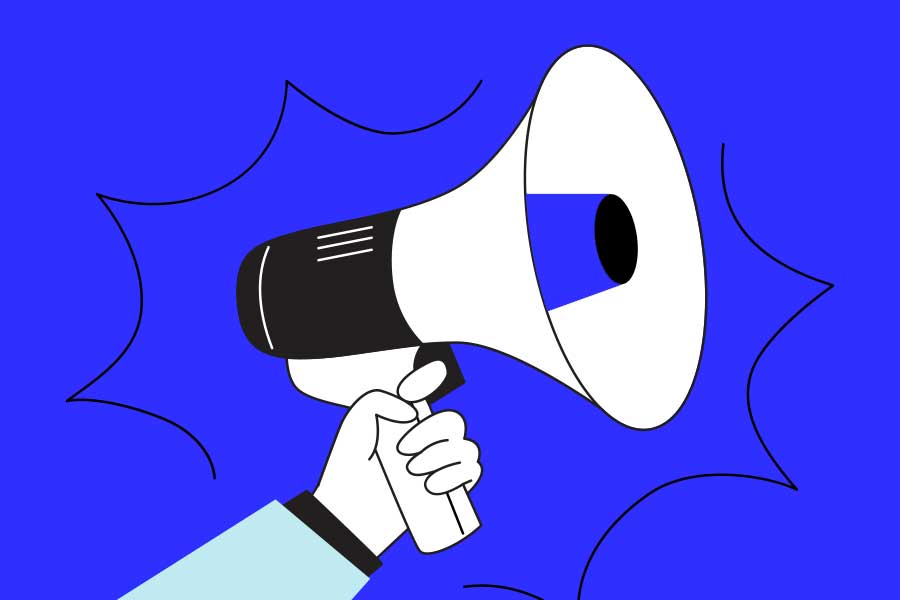New and established brands alike are constantly looking for effective ways to grow their brand. By increasing customers with as small an investment as possible, companies of all sizes can make more money and grow their success – all without blowing through a huge marketing budget. One such method that has proven effective is referral marketing (a customer referral program).
Referrals are a natural way to boost your business. When customers are in need of a new service, or have had a great experience with a new company, where do they go? They talk to their network, of course.
By getting in touch with friends and family members, customers recommend businesses to one another through word-of-mouth marketing. This is especially effective because:
- People are more likely to follow up on the advice of those they know and trust.
- It doesn’t require a marketing budget.
Referrals take place when an individual, the referrer, mentions your business to someone they know. By recommending or just talking about their great experience, current customers are spreading your business through word-of-mouth marketing. AKA, referral marketing.
In fact, referrals can account for huge growth. A whopping 78% of B2B marketers say referral programs bring good to excellent leads, while 60% say referral programs draw a large number of leads.
A referral program provides a scalable way to measure and track all of that growth.
What is a referral program?
A referral program allows current customers to easily share their experience with a company to those they know, and standardizes the process of sharing.
An incentive is often used to entice both ends of the deal. Current customers earn a reward for completed referrals, and new customers earn the same or a similar reward for themselves. Rewards are often cash, discounts, or free products.
Companies use smart and helpful referral software to keep track of it all. Meanwhile, continuous business growth means revenue boosts.
Here’s an example: A company sells homemade furniture and they implement a referral program. Any customer who brings a sale from a new, happy customer earns $50, while the new customer gets $50, too. Referral programs can offer dollars off or free products as incentives as well.
By offering a reward, current customers are motivated to encourage others to shop at your business, while new customers are enticed with dollars off or a cash reward. All while your business earns. It’s a win-win-win marketing program.
Benefits of referral programs
Setting up a referral program comes with many perks, including:
- Increased revenue for your business
- Involved customers who sing your praises
- A revolving source of new customers (who then join the referral program themselves)
- Minimal marketing expenses
- Referral programs are cost-effective
- Referral programs are low-risk
- Referral programs generate repeated word of mouth
- Referred customers are high-value (more likely to stay loyal to your business)
- Referral programs help businesses generate higher revenue and ROI
We’ve talked about most of these perks, such as growth and a growing customer base, but let’s consider your marketing budget. Referral programs come with a much lower CAC (customer acquisition cost) than most marketing efforts.
Because leads are coming in warm and informed – after learning what you do and getting a good review from an acquaintance – they’re already ready to sign up. Minimal convincing on your part. This means fewer dollars are needed to be spent on marketing on your end.
Meanwhile, the fees you are spending are more than covered by the new business revenue. For instance, if you’re giving cash back or an Amazon card, each new customer is bringing in far more than that, so you still profit in the process.
Other types of marketing require thousands spent with no guarantee on ROI. With referral marketing, there are no dollars spent on advertising, just new users coming in. You only pay when you sell.
In addition, with incentives, customers are encouraged to keep sharing to fresh leads (who then can also refer others). These customers are also high-value. Because they feel appreciated and have something to gain, they are far more likely to stay loyal to your brand for long periods of time.
Referral marketing logistics
Now let’s talk about crossing your Ts and dotting your Is. You might be thinking that these programs seem like it’s a lot to keep up with. However, thanks to referral software, you can leave out the paperwork altogether.
Referral software keeps track of all the tough stuff at a minimal cost. You only pay when leads come in, and there’s no need to follow up on incentives manually.
By setting up effective landing pages, then tracking user activity via automation, you have a better idea of what customers want. You can predict a first purchase, enhance your digital marketing, and more.
Referral programs create empowered, lasting advocates for your brand. Consider using them to grow through word-of-mouth marketing, all while creating an extremely loyal customer base.
How to build a referral program: Laying the foundations
Now it’s time to talk about your beginning steps before putting your referral marketing plan in place. In order to have a successful referral marketing program, you should ensure that these logistics exist within your brand.
Provide exceptional products and/or services
Whatever you do, do it well! Your business should provide great products and services for your customers. In order to provide a program that they can share, it’s important to have a solid, high-quality business in place that patrons will be proud to brag on. Ensure your business is offering quality products or services, and great customer service.
This is one of the main building blocks to creating a thriving referral marketing program.
Know you have customers who are willing to share
Another important step is ensuring that your customers are willing to help market your business. Do this by looking at your loyalty base. Are current customers active on social media? Do they order or schedule regularly? Do they leave high-quality reviews? Do they engage positively through customer service channels?
Finding customers who engage in some or all of these channels can create a solid base for your referral marketing program. It’s these customers who are most likely to draw in the most referrals and remain loyal customers.
Develop strong relationships with customers
There are several ways that you can develop strong relationships with your customers, including:
- Offering them positive feedback: Tell customers you appreciate them. Send coupons, share deals, and keep in touch. Remaining active and showing your thanks can go a long way in customer retention.
- High-quality customer service: If your customers have a question, how quickly and effectively they get a response will go a long way in their loyalty. Train your customer service reps and ensure they offer great experiences to develop stronger relationships with your customers.
- Recognize them: Another step in gaining trust comes with simply recognizing your customers. Send an email thanking them for their purchase. More personalized efforts can also be taken, such as hand-written thank-you notes, or even swag can gain and maintain their loyalty.
These are a few steps to obtaining customer trust. Creating a strong business that thanks its patrons goes a long way in encouraging sharing. Keep these smart tactics in mind when promoting your referral business.
Have clear marketing goals in mind
Another way to streamline your success in a referral marketing program is to have clear goals of your best customers. Know your ideal shoppers’ ages, locations, preferences, etc. When you know who you want to reach, you can better point your marketing efforts to find them.
Some key marketing goals a business might have are increasing customer loyalty, driving brand awareness, and increasing ROI.
With smart referral software or other analytics tools, you can track starting points on these factors, and then check up as you go. Consider how you will following these goals and ensure that your brand is reaching key milestones.
With clear marketing efforts in place, you can align your referral program to meet and attain your best customers.
Select the right referral program rewards
How to create a referral program that convinces customers to share? Finding the best marketing strategy involves reaching customers with the referral rewards they are most interested in. This goes hand in hand with knowing your market. If you know who you’re reaching, you know what they’ll most react to.
For instance, if you sell an expensive product, customers are unlikely to be enticed by a few dollars or a small percentage off. However, if you offer a free product or a sizable amount back, they’re far more likely to bite.
This goes for repeat and new customers. Find what interests them and make it happen with your referral program.
Figure out who to reward
There are multiple formats you can implement with your referral program. You can reward existing customers, new customers, both, or even none of the above. Successful referral programs come in all shapes and sizes, however, many programs with the most growth offer some type of reward system through their referral process.
Think about it, rewards are meant to entice. That means when a customer is getting something for their efforts – or new customers are getting a deal – folks are more likely to seal the deal. But there’s a different fit for every industry and every business model, so it’s important to find the right referral program for you.
One-sided incentives
One-sided incentives mean that only one person gets an incentive, either the current customer or the new customer. This can mean a lowered acquisition cost per transaction. However, it can also mean fewer leads.
While customers will be motivated to market, or new customers excited to sign up, the other side of the transaction is far less motivated. Overall, this can lead to fewer referral leads and business growth.
Two-sided incentives
With two-sided incentives, both sides of the equation receive a reward. Customers get something, as do the new folks coming in.
These referral reward programs are the most successful. With everyone having something to gain, all parties are more likely to complete transactions. And because new customers mean earned dollars,
No incentives
Some referral programs don’t offer customer rewards at all. In these programs, customers are encouraged to share your brand with others, but neither party is incentivized.
These programs can find it hard to gain traction – without the additional draw, many customers aren’t motivated to market on your behalf. While new parties might be slow to sign up. These types of referral programs usually find little success.
What type of reward to offer?
Now it’s time to decide how to incentivize your market. Look back at your research. What types of rewards will your market best respond to? In most cases, there are three options:
- Cash: pay via Paypal or prepaid Visa card
- Free product or service: often redeemable with a code
- Percentage off: also redeemable with a code
Cash needs no introduction. Everyone loves cash. Find an amount that’s comparable to your price point, and step back and let customers work to earn a referral fee.
With a free product or service, you can offer items that are related to your industry, or come from left field with valuable free items that your market will be interested in receiving.
Or, a percentage off can entice them to buy something new. With the promise of a great deal, customers are more likely to sign up for more – and to keep the referrals pouring in.
Whenever possible, tying the reward back to your brand can help perpetuate your growth. As you’re constantly bringing in new leads, loyal customers will return for more business. Branded free products, cash to spend, or dollars off a service can all help promote your cause.
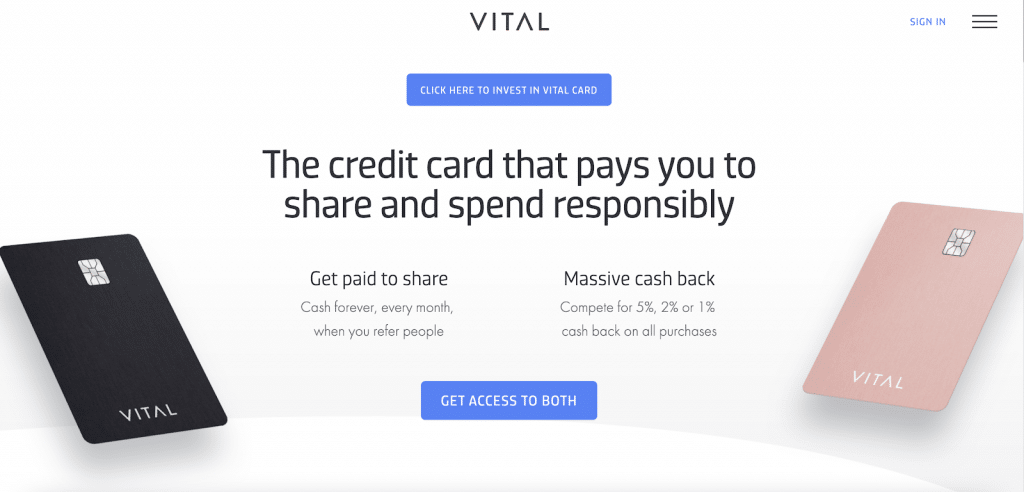
For example, the Vital credit card offers cash rewards for the use of their card, as well as referring friends.
There are key benefits to each type of program. The best way to find the most success is by evaluating your market base and implementing the route that will most appeal.
Create a reward structure
Next, it’s time to create your reward structure for the best referral program. This is the bones of your referral program and will be what excites subscribers to join in.
Figuring out a reward program that works best for your business model means finding out what your customers value, and what will entice them to share your brand. For instance, while a restaurant will see perks to handing out free food items, B2B referral programs and SaaS referral programs will likely see benefits in offering a free month of service or bonus feature.
Find the best reward structure by asking yourself these questions:
- Who are my customers? What type of reward would most excite them?
- How can I advance customer loyalty?
- Do the rewards align with my business model?
- Should I offer monetary or non-monetary benefits?
Cash is often the most eye-catching reward, but it’s not the only option for a referral program. There are also referral rewards that are as good as cash, offering store value. For example:
- Coupons
- Points or store credit
- Freebies or upgrades
- Branded swag
- Universal gift cards or cards for big brands (pre-paid Visa card, Target, Best Buy, etc.)
- Charitable donations
You can also choose from different reward structures.
- You could offer one reward that is standard – the same across the board, with no change in rewards per customer brought in.
- Tiered rewards offer different amounts of reward for each number of referrals. There are programs that offer a big reward the first time around, then less in subsequent referrals, or vice versa.
- There are also multi-step rewards, when customers receive a reward after they’ve reached a target number of referrals.
Decide which route will most entice your ideal audience and you can create a wildly successful referral marketing program.
Build a referral program that converts
The biggest goal of all is to convert potential customers. Sure, it’s good to gain warm leads, but until the customer actually signs up, you haven’t earned. That’s also why referral incentives aren’t awarded until the customer has signed the deal.
Therefore, you need a referral program that not only entices, but converts. This can be done with SEO, strong calls to action, and more.
Your referral program page is a reflection of your brand and shows customers how you interact. You want your message to be clear. Tell customers what they get, and why they should refer you. Remember, this page may be the first interaction someone has with your brand; you want to win them over.
Use catchy headlines
Get customers’ attention with headlines that are clear and effective. Your headlines will cut to the chase while piquing their interest. Headlines that grab attention say things like:
- Refer and earn
- $20 cash when you refer a friend
- 15% off for sharing with friends
- Share and save $30 on your next order
- Share the love, get rewarded
- $5 for you, $5 for a friend
- Get free [products] when you share
Create your referral messaging
Your referral message tells your story. It tells existing customers what exactly you want them to share with peers, and it gets sent to their friends to make a first impression.
Messages that are pre-filled and ready to send make it even easier for customers to share with the masses. So, referral programs that have pre-written messages see better results. Customers enjoy having the option to write their own message, but some might be intimidated by writing their own message.
Customers who are brand new to your business will have several questions. You can answer them in a brief message to further entice.
- Explain the benefits from the get-go. What’s the draw?
- Read clearly so it’s easy to understand; don’t leave any questions.
- Be personal.
- Leave with a clear call-to-action – let them know what their next steps are.
Make referring oh-so-easy
Messaging isn’t the only way you can make referring easy. Remember, the harder it is for customers to provide referrals, the less likely they are to do it. Even with the promise of a reward, folks won’t go to additional effort if you’re making them jump through hoops.
However, by making it easy for them, you can maximize their participation and your referral program’s success.
Give customers multiple ways they can share – this increases the chance that they will refer. If they don’t have Facebook, they might use Instagram. Or if they don’t like texting, they may use email. You can also offer QR codes or even printed material, like business cards. And including a unique referral link or referral code tied back to each customer will let them share however they please.
Successful programs let their customers choose how they will share their referral to others. Paired with a pre-filled message, and you’ve made it easy for folks to share the good word. And of course, be sure to promote your referral program once it’s live, so your customers know how easy sharing can be!
Track referral progress with analytics
The best way to ensure your referral program is successful is by following analytics. With tracking and analytics, you can see how many people are visiting your page, how many sign up, and even how many referrals come in from each customer. You can make tweaks to your referral page to see if it drives more conversions. Or simply track ROI and see how many dollars your referral marketing program is bringing in.
Without analytics, you won’t know what verbiage is most effective for your customers. You won’t know what’s driving them to sign up, and more. That’s why it’s important to have referral software for your marketing program. Software will track and create analytics, allowing you to make marketing moves based on real customer data models.
Use referral program software to grow your marketing program
With the use of referral program software, you can accurately follow the success of your referrals. Track real-time data that shows you what customers are responding to, what spikes their interest, and ultimately, how to best convert your referral marketing program.
Referral software provides a turn-key effort in implementing and tracking your referral program. It provides key benefits like tracking your ROI, listing conversion rates, and even distributing rewards to earning customers.
Not all referral marketing software programs are the same. In fact, affiliate or loyalty software programs can be beneficial in their own right, but won’t provide accurate data when following customer behavior (tying individual shares and purchases back to a customer advocate).
Because referral programs are all about boosting your brand through word of mouth, you’ll need software to help these efforts along. Customer service is an added benefit that comes with referral marketing software, allowing you to step back and let the program essentially run itself. Or rather, let your customers provide marketing that helps you grow.
There are many existing brands that offer referral marketing software, including:
- Referral Rock: Referral Rock provides software that helps all industries design a referral program, track your rewards, and manage growth on a user-friendly platform.
- ReferralCandy: ReferralCandy is designed to help eCommerce websites build, run, and follow their referral marketing program.
- Talkable: Talkable is also a referral program software that specializes in building and tracking eCommerce referral programs.
- AdvocateHub by Influitive: The AdvocateHub by Influitive program works by allowing B2B companies to find growth through customer excitement.
- Extole: Extole helps enterprise, eCommerce, and SaaS brands build referral programs, and works with big names, but it is on the expensive side.
- Ambassador: Ambassador is a brand of software for referral marketing and affiliate marketing software. They’ve announced that they’re sunsetting their service, though, and aren’t currently accepting new customers.
For more details, check out our complete list of referral software options.
Find inspiration with these successful referral programs
Successful referral programs have helped all types of businesses find and grow a broader customer base. By implementing smart referral programs that enticed and captured new customers, companies were able to grow their brand and increase revenue in the process.
Take a look at these thriving models for inspiration as to how you can grow your own brand through referral marketing.
Dropbox
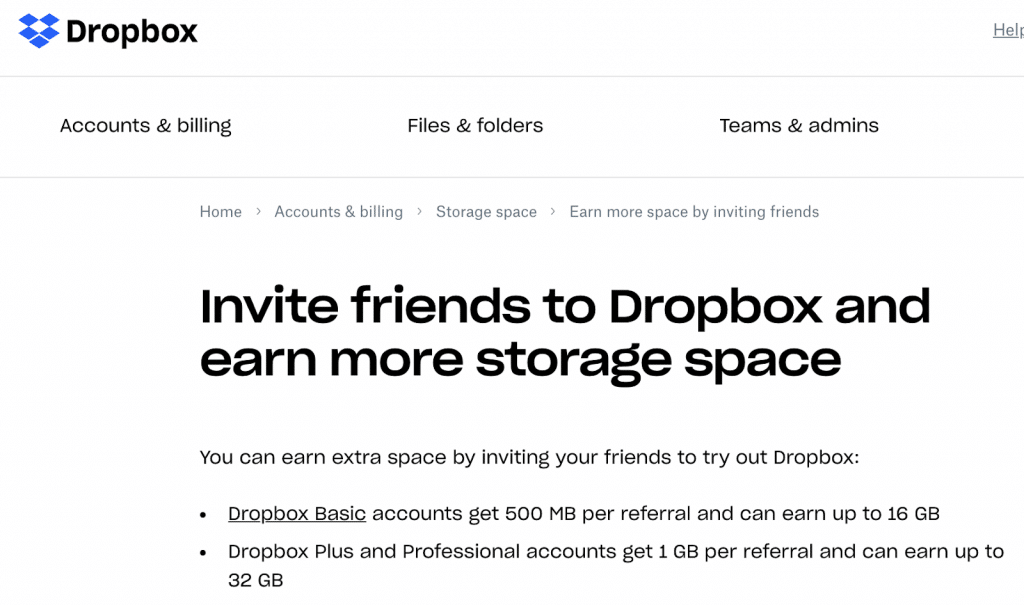
Dropbox’s referral program works by adding more storage space to users’ accounts when they successfully convert a new customer. Free accounts earn 500 MB per referral, topping out at 16 GB, and paid accounts earn 1 GB a pop, topping out at 32 GB of additional storage space.
Their referral program has proved successful, encouraging customers to invite new customers, while rewarding their existing users to keep inviting.
Uber
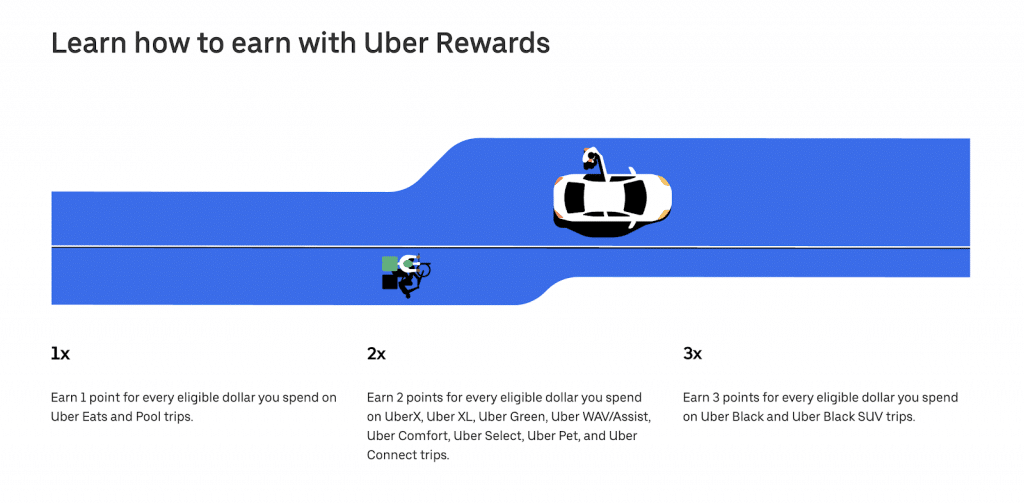
Uber has created an entire rewards system for its users. Based on the use of travel and food services, each Uber user can earn points. The more they use it, the higher the points tier that they fall within. Therefore, the more they can earn.
This program operates on a “the-more-you-use-the-more-you-earn” model. The highest-level users have achieved diamond status, which is achieved at 7,500 points. These users earn the most benefits, including the best drivers, flexible cancelations, and priority pickups from key locations, like the airport.
Uber has found a smart way to reach its customers by offering more perks for their best, most frequent users. In addition, it encourages more usage by tieing in travel and food delivery portions of the brand.
Airbnb
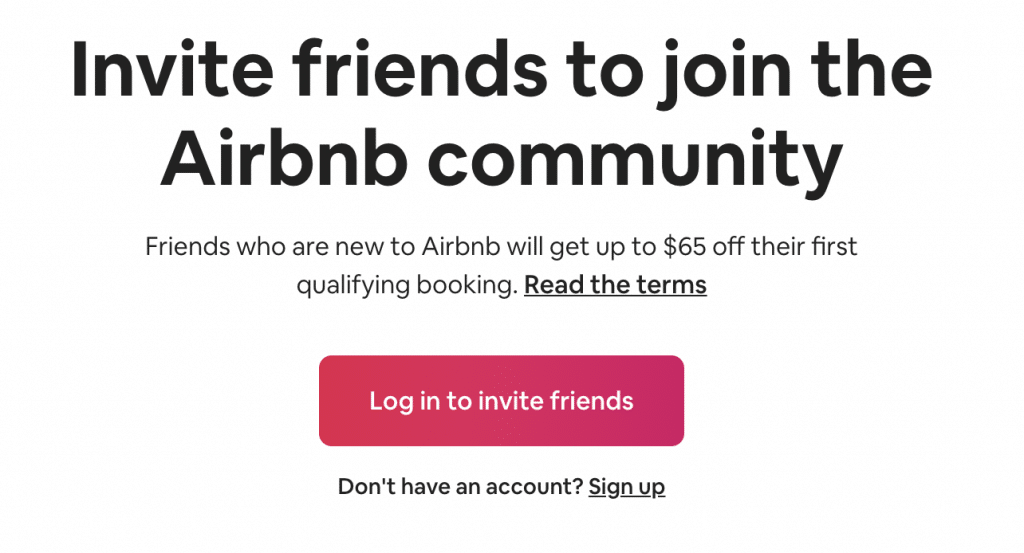
Users earn free travel points when referring to Airbnb. This travel site found a way to implement rewards that 1) relate to their business and 2) are attractive to their customer base. By offering more ways to travel, existing customers are encouraged to share the brand with the masses.
Harry’s

Harry’s razor delivery program made waves when it gathered more than 100,000 emails before its official launch. Even more impressive is that they did it in a single week. The brand built its entire marketing efforts through referrals before they even started offering razors to the public. With their original referral program, refer-a-pal, users earned access to prizes (shaving-related goods) by sharing their friends’ email addresses. Paired with a playful message, the brand skyrocketed itself through this unique approach to referral marketing.
Evernote

Evernote is a software program (computers and apps) that helps people make and track lists. Their referral program gives users the chance to earn points – 10 per friend and 5 subsequent points for secondary referrals or a premium member. Customers earn a chance at free access to Evernote’s paid version, Evernote Premium. Normally valued at $7.99 a month, this is a great referral program example of introducing customers to higher-level services as a reward for their referrals.
Tesla
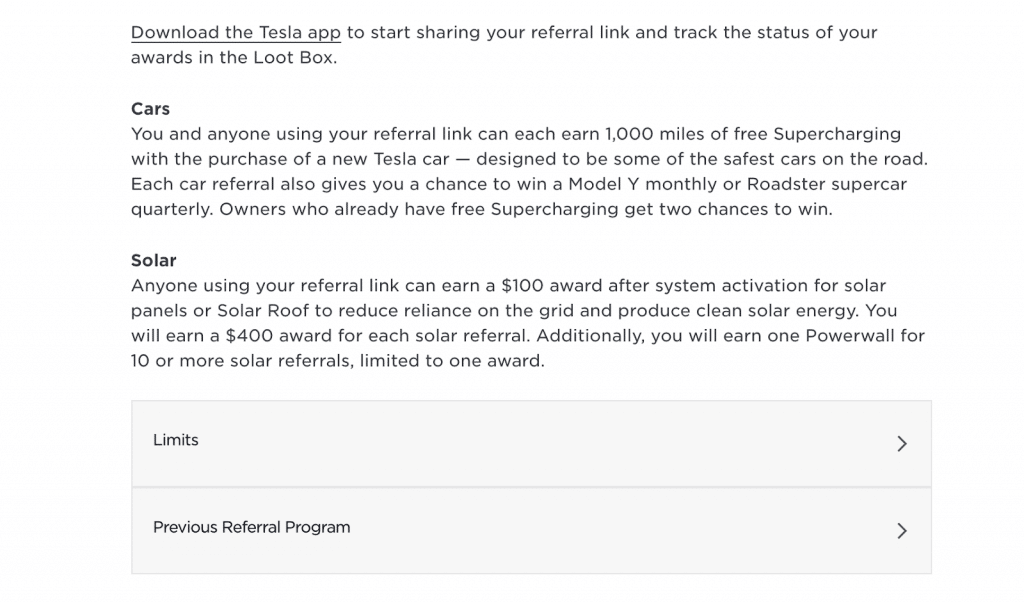
Electric car company, Tesla, made waves with its high-profile referral program. With an expensive product in play, this is a great example of how to appeal to customers with bigger ticket items. For their reward company, Tesla offers two types of rewards. Customers who have a Tesla car can earn 1,000 miles of free Supercharging when a referral purchases a new car. The referral also comes with the chance to win a car. Drawings take place every quarter.
Customers referring folks to Tesla’s solar panel program can earn $400 per referral. They can also earn a Powerall, a form of off-the-grid power storage, after 10 referrals.
These high-ticket rewards can help entice high-ticket customers who refer their friends and family members.
Start your own referral program
Referral marketing comes with many benefits, and is adaptable for brands in all industries. By identifying your key marketing and creating a program that entices them to share with their friends, you can greatly increase your business through word-of-mouth marketing. Better still is that you develop closer relationships with existing customers and draw upon repeat business.
Referral programs are a great way to grow your business with warm leads, and without increasing your marketing budget or efforts.
You can also make your referral program more effective with the use of the software. Referral marketing software helps you build, track, and manage your referral program on all fronts. Keep track of your ROI, and implement better customer service with smart referral software.
For more resources you can use to build your referral program, check out these related articles:
